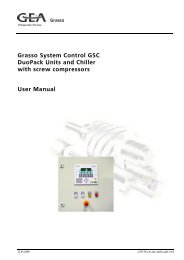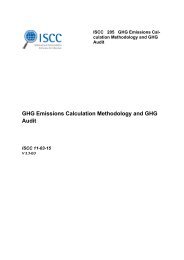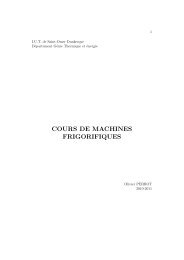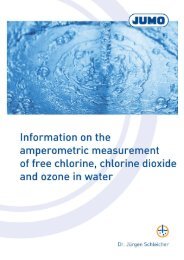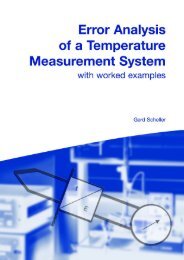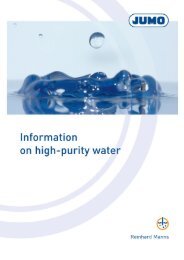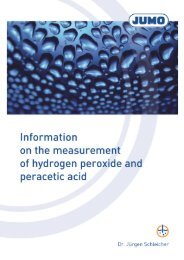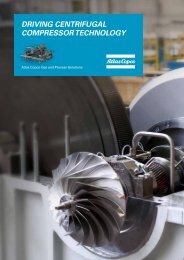FAS622en_pH measurement
Create successful ePaper yourself
Turn your PDF publications into a flip-book with our unique Google optimized e-Paper software.
2 Measurement<br />
2.2.5 Buffer solutions<br />
<strong>pH</strong> buffer solutions are used as a means of calibrating <strong>pH</strong> electrodes. They are aqueous solutions<br />
with known <strong>pH</strong> values. Buffer solutions are categorized into primary reference buffer solutions, secondary<br />
reference buffer solutions and technical buffer solutions, according to their properties.<br />
Primary reference buffer solutions show the lowest uncertainty in <strong>pH</strong> values (U(<strong>pH</strong>) = 0.003). They<br />
are used mainly in metrological institutes and are not available commercially.<br />
Secondary reference buffer solutions have the same composition as primary solutions. The uncertainty<br />
of the <strong>pH</strong> values is around U(<strong>pH</strong>) = 0.006. These solutions are needed by manufacturers of<br />
technical and working reference buffer solutions, and by control and quality assurance laboratories.<br />
Technical buffer solutions are solutions for practical use; their uncertainty is in the range from U(<strong>pH</strong>)<br />
= 0.01 to U(<strong>pH</strong>) = 0.05. Technical buffer solutions are the robust solutions. They are relatively immune<br />
to contamination and dilutions, and so are best suited for calibration of plant and hand-held<br />
meters.<br />
There are <strong>pH</strong> buffer solutions for almost the entire range of the <strong>pH</strong> scale. For routine work, two solutions<br />
with <strong>pH</strong> values of approx. <strong>pH</strong> = 7 and <strong>pH</strong> = 4 are adequate for a <strong>pH</strong> range from <strong>pH</strong> = 2 to<br />
<strong>pH</strong> = 10. Basic buffer solutions are often very unstable and many <strong>pH</strong> electrodes react very sluggishly<br />
in them. Because of this, the slopes in basic solutions are shallow in most cases. Practical calibrations<br />
with basic buffer solutions can only be achieved by excluding air from the solutions and<br />
allowing a relatively long settling time. This effort is only worthwhile for <strong>measurement</strong>s in the laboratory.<br />
The exclusion of air prevents any change in the <strong>pH</strong> of the buffer solution as a result of atmospheric<br />
carbon dioxide being absorbed.<br />
People often talk about the traceability of the buffer solutions. The traceability concerns the <strong>pH</strong> value<br />
of the <strong>pH</strong> buffer solution. It means that the <strong>pH</strong> value was tested by the manufacturer either directly<br />
against a primary reference buffer solution, or via intermediate solutions (e. g. secondary reference<br />
buffer solution).<br />
Example<br />
technical buffer solution r sec. reference buffer solution r prim. reference buffer solution<br />
or technical buffer solution r prim. reference buffer solution<br />
The traceability of the <strong>pH</strong> value forms a basis for calculating the uncertainty.<br />
Note<br />
During calibration, please take into consideration that the <strong>pH</strong> of the buffer solution alters with temperature.<br />
24 2 Measurement JUMO, FAS 622, Edition 04.07



